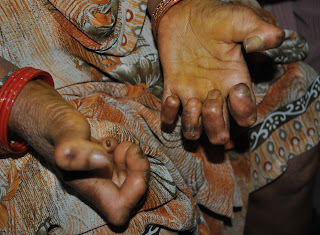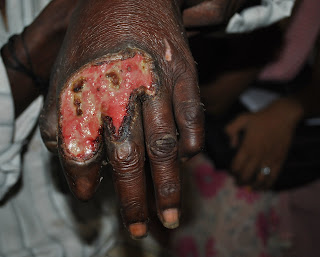Date: 07/29/2011
Her hands were the first thing I noticed. The nails were of many different abnormal shapes. Some were quite dirty. The fingers all curved inwards, incapable of stroking the soft cheek of her grandson or holding a glass of water on a hot summer day in India. Some of the fingers were swollen and many bore scars-- some healed others in the process of doing so. I felt extremely aware that I was in the presence of an ancient disease. It felt bizarre. The scabs on her fingers seemed incongruous. We are in 2011. Hadn’t we dealt with this scourge already?
Her hands were the first thing I noticed. The nails were of many different abnormal shapes. Some were quite dirty. The fingers all curved inwards, incapable of stroking the soft cheek of her grandson or holding a glass of water on a hot summer day in India. Some of the fingers were swollen and many bore scars-- some healed others in the process of doing so. I felt extremely aware that I was in the presence of an ancient disease. It felt bizarre. The scabs on her fingers seemed incongruous. We are in 2011. Hadn’t we dealt with this scourge already?
 |
| I can't believe this happens in 2011! |
The long auto-ride to the place had been immensely bumpy and there were many moments when I thought I was going to fall out of the auto, but I was finally at the Shieffelin Leprosy Research and Training Centre in Karigiri near Vellore, an edifice for India’s long struggle against Leprosy. It was here that the famous Dr. Paul Brand, an amazing figure in the world of Leprosy and surgery, had first done the extensor-flexor four tailed tendon transfer to return some function to hands like the one in the picture above. Once there, I met the director Dr. Mannam Ebenezer, an orthopaedics surgeon who specializes in operating on bone deformities due to Leprosy. He directed me to Dr. Jyothi Nirmala. Dr. Jyothi was absolutely fantastic. She started out by grilling me on my knowledge of Leprosy. I felt really glad that I had managed to finish the Harrison’s chapter in the auto so I didn’t look like a complete idiot. Subsequently, she showed me how to palpate the nerves that are typically inflamed in Leprosy and examine some of her patients who presented with different stages of Leprosy. I must admit it was initially difficult for me was to act perfectly detached in front of the patients and not allow the emotions deep within my heart to bubble to the surface. I am glad I managed it. The last thing they need is a person in the medical setup to react with horror when confronted with their cosmetic devastation. I made it a point to touch them on the arm when I said "Nandri" (thanks) to them after they agreed to being photographed.
 |
| This wretched bacterium, not God's wrath, gives people Leprosy. Image courtesy: www.pathmicro.med.sc.edu |
You see, Leprosy is really a bacterial disease of the nerves. Mycobacterium leprae is really the weakling cousin of the notorious M. tuberculosis. Indeed, they’re so similar that the BCG vaccine for tuberculosis also protects us from leprosy according to some studies. M. leprae likes to attack nerves in the cooler peripheries of our body like the skin, the eyes, and the testes. Unlike M. tuberculosis, it’s not very effective at establishing an infection at all. In fact, 95% of us are naturally immune to it. It hasn’t yet been established what makes 5% of us vulnerable to infection. It has to do with some impairment of a branch of immunity called cell-mediated immunity (CMI). I suspect that there’s a genetic component to this susceptibility. Even then, it takes 7-12 years of contact to contract the disease and the incubation period can range from 2 months to 40 years. Shaking hands or having lunch with a leprosy patient will not give you leprosy. The exact mode of spread hasn’t been definitively established yet, but the infectivity is low and the spread of the disease slow.
Leprosy presents classically with a depigmented patch of the skin. There is some loss of sensation in these patches because Leprosy, remember, attacks the nerves. Based on the number and shape of the skin lesions and some other markers, the disease can be graded from the most controlled and limited (tuberculoid) to the most diffuse and poorly controlled (lepromatous). The major problems and deformities occur because of the nerve damage. Patients don’t realize when they get hurt and the consequent injuries accrue into deformities. For instance, cooking is a real hazard for people with leprosy because they don’t know when they’re touching something hot. This is why Dr. Jyothi provides them with microcellulose rubber gloves to wear on their hands while working to prevent injury. The injuries can lead to profound ulcerations that can be cosmetically disfiguring. They are also provided custom made shoes to avoid further injuries to their already deformed feet.
 |
| This poor man got injured while tending his cattle. He didn't notice the injury because of his lack of sensation and the small injury grew into this massive ulcer. |
The bacterial attack on the nerves can also result in deformities directly. For instance, the attack on the ulnar and median nerves in the arm causes the clawing of the hand as seen in the picture above and peroneal nerve degeneration in the leg results in foot drop and difficulty walking. Another serious deformity occurs when the nerves to the orbicularis oculi get injured in Leprosy. The patient is unable to close his eyelids fully even when he’s sleeping! As a result, the cornea dries out and this can lead to blindness.
 |
| How can this foot be comfortable in a normal shoe? It's not safe for them to walk barefoot. |
It’s really important to note that the disfiguration that stigmatizes Leprosy is the result of nerve damage, not a direct attack of the bacteria on the skin. Therefore, it becomes important to start the antibacterial therapy as quickly as possible to prevent the permanent loss of sensation and the contractures of the fingers.
 |
| A granuloma in which the cells of the immune system are walling off bacteria from the rest of the body so that they cannot spread to other sites. Image coutesy: humpath.com |
As I mentioned before, our body depends on its cell mediated immunity (CMI) to deal with leprosy bacteria that hide within our cells. The CMI response prevents intracellular bacteria like M. tuberculosis and M.leprae from spreading around by walling them off in structures called granulomas.If our body has a strong CMI, it favours tuberculoid leprosy with very few well circumscribed lesions, but, when it gets weak, the bacteria spread and produce the lepromatous type of infection which is far more infectious, not to mention deformities accrue with time. One of the precipitating factors for a weak CMI is actually malnutrition. Cegielski et al. described how a deficiency of proteins in a person’s diet can drastically weaken their CMI and predispose them to conditions like tuberculosis(1). Given the immense similarities in M. tuberculosis and M. leprae, I really believe that when patients with leprosy are ostracized by society and forced into abject poverty, the consequent malnutrition can decimate their CMI and push them from the rapidly treatable tuberculoid form towards the dreaded lepromatous form of the disease which is difficult to manage and treat. As I mentioned in a previous post, this creates a vicious cycle of fear.
 |
| We just don’t realize how lucky we are. |
I thanked Dr. Ebenezer and Dr. Jyothi for being such wonderful hosts and teaching me so much. Before I left, Dr. Ebenezer invited me to come back to do leprosy research in my senior year. This is an offer I’ll definitely consider very strongly. I hailed an auto and headed back to CMC. On the way, the auto zoomed over some train tracks so violently that I pitched sideways and nearly out of the auto. Reflexively, I grabbed one of the iron bars in the auto and managed to not tumble violently onto the tracks. As my heart rate returned to normal, I gazed at my strong fingers that enjoyed a complete range of motion. I couldn’t stop looking at them for a while.
Disclaimer: The patient photos were clicked only after ascertaining consent. I deliberately didn't take any photographs with their faces lest they be stigmatized any further.
Bibliography:
1. The relationship between malnutrition and tuberculosis: evidence from studies in humans and experimental animals. Cegielski, J.P., McMurray, D.N., International Journal of Tuberculosis and Long Disorders 8(3):286–298, 2004.
very good article.
ReplyDeletea good article
ReplyDeleteThank you!
ReplyDelete